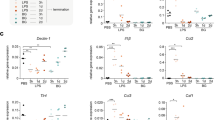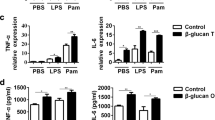Abstract
Sepsis is defined as a dysregulated host response to infection that leads to multiorgan failure. Innate immune memory, i.e., “trained immunity”, can result in stronger immune responses and provide protection against various infections. Many biological agents, including β-glucan, can induce trained immunity, but these stimuli may cause uncontrolled inflammation. Oroxylin A (OA) is an active flavonoid compound that is derived from Scutellaria baicalensis. OA is an agonist for inducing trained immunity in vivo and in vitro, and β-glucan was used as a positive control. The protective effects of OA-induced trained immunity were evaluated in mouse models that were established by either lipopolysaccharide (LPS) administration or caecal ligation and puncture (CLP). The expression of inflammatory factors and signaling pathway components involved in trained immunity was evaluated in vitro using qRT‒PCR, western blotting (WB) and enzyme-linked immunosorbent assay (ELISA). Flow cytometry and confocal microscopy were used to examine reactive oxygen species (ROS) levels and phagocytosis in trained macrophages. A PCR array was used to screen genes that were differentially expressed in trained macrophages. Here, we revealed that OA alleviated sepsis via trained immunity. OA-treated macrophages displayed increased glycolysis and mTOR phosphorylation, and mTOR inhibitors suppressed OA-induced trained immunity by effectively reprogramming macrophages. The PCR array revealed key genes in the mTOR signaling pathway in OA-treated macrophages. Furthermore, OA targeted the Dectin-1-syk axis to promote LC3-associated phagocytosis (LAP) by trained macrophages, thereby enhancing the ability of these macrophages to protect against infection. This ability could be transferred to a new host via the adoptive transfer of peritoneal macrophages. This study is the first to provide new insights into the potential of OA-induced trained immunity to be used as a strategy to protect mice against sepsis by promoting LAP by macrophages.









Similar content being viewed by others
Data Availability
No datasets were generated or analysed during the current study.
Abbreviations
- AST:
-
Aspartate aminotransferase
- ALT:
-
Alanine aminotransferase
- CLL:
-
Clodronate liposomes
- CLP:
-
Cecal ligation and puncture
- CMC-Na:
-
Carboxymethyl cellulose-Na
- DMSO:
-
Dimethyl sulfoxide
- ELISA:
-
Enzyme-linked immunosorbent assay
- H&E:
-
Hematoxylin and eosin staining
- IHC:
-
Immunohistochemistry
- LPS:
-
Lipopolysaccharid
- LAP:
-
LC3-associated phagocytosis
- OA:
-
Oroxylin A
- PFA:
-
Paraformaldehyde
- ROS:
-
Reactive oxygen species
- WB:
-
Western blotting
References
Paoli, C.J., et al. 2018. Epidemiology and Costs of Sepsis in the United States-An Analysis Based on Timing of Diagnosis and Severity Level. Critical Care Medicine 46 (12): 1889–1897. https://doi.org/10.1097/CCM.0000000000003342.
Liu, Z., P. Mahale, and E.A. Engels. 2019. Sepsis and Risk of Cancer Among Elderly Adults in the United States. Clinical Infectious Diseases 68 (5): 717–724. https://doi.org/10.1093/cid/ciy530.
Marakalala, M.J., et al. 2013. Dectin-1 plays a redundant role in the immunomodulatory activities of beta-glucan-rich ligands in vivo. Microbes and Infection 15 (6–7): 511–515. https://doi.org/10.1016/j.micinf.2013.03.002.
Kalafati, L., et al. 2020. Innate Immune Training of Granulopoiesis Promotes Anti-tumor Activity. Cell 183 (3): 771-785.e12. https://doi.org/10.1016/j.cell.2020.09.058.
Kleinnijenhuis, J., et al. 2012. Bacille Calmette-Guerin induces NOD2-dependent nonspecific protection from reinfection via epigenetic reprogramming of monocytes. Proc Natl Acad Sci U S A 109 (43): 17537–17542. https://doi.org/10.1073/pnas.1202870109.
Naik, S., et al. 2017. Inflammatory memory sensitizes skin epithelial stem cells to tissue damage. Nature 550 (7677): 475–480. https://doi.org/10.1038/nature24271.
Li, C., G. Lin, and Z. Zuo. 2011. Pharmacological effects and pharmacokinetics properties of Radix Scutellariae and its bioactive flavones. Biopharmaceutics & Drug Disposition 32 (8): 427–445. https://doi.org/10.1002/bdd.771.
Wei, L., et al. 2017. Oroxylin A activates PKM1/HNF4 alpha to induce hepatoma differentiation and block cancer progression. Cell Death & Disease 8 (7): e2944. https://doi.org/10.1038/cddis.2017.335.
Huo, T.X., et al. 2022. Oroxylin A inhibits the migration of hepatocellular carcinoma cells by inducing NAG-1 expression. Acta Pharmacologica Sinica 43 (3): 724–734. https://doi.org/10.1038/s41401-021-00695-4.
Liu, Y., et al. 2020. Oroxylin A reverses hypoxia-induced cisplatin resistance through inhibiting HIF-1alpha mediated XPC transcription. Oncogene 39 (45): 6893–6905. https://doi.org/10.1038/s41388-020-01474-x.
Tseng, T.L., et al. 2012. Oroxylin-A rescues LPS-induced acute lung injury via regulation of NF-kappaB signaling pathway in rodents. PLoS ONE 7 (10): e47403. https://doi.org/10.1371/journal.pone.0047403.
Yao, J., et al. 2014. Oroxylin A prevents inflammation-related tumor through down-regulation of inflammatory gene expression by inhibiting NF-kappaB signaling. Molecular Carcinogenesis 53 (2): 145–158. https://doi.org/10.1002/mc.21958.
Pan, Y., et al. 2022. beta-glucan-coupled superparamagnetic iron oxide nanoparticles induce trained immunity to protect mice against sepsis. Theranostics 12 (2): 675–688. https://doi.org/10.7150/thno.64874.
Sun, Z., et al. 2020. 17beta-Estradiol Promotes Trained Immunity in Females Against Sepsis via Regulating Nucleus Translocation of RelB. Frontiers in Immunology 11: 1591. https://doi.org/10.3389/fimmu.2020.01591.
Divangahi, M., et al. 2021. Trained immunity, tolerance, priming and differentiation: Distinct immunological processes. Nature Immunology 22 (1): 2–6. https://doi.org/10.1038/s41590-020-00845-6.
Akoumianaki, T., et al. 2021. Uncoupling of IL-6 signaling and LC3-associated phagocytosis drives immunoparalysis during sepsis. Cell Host Microbe 29 (8): 1277-1293 e6. https://doi.org/10.1016/j.chom.2021.06.002.
Sun, Z., et al. 2021. 17beta-Estradiol promotes LC3B-associated phagocytosis in trained immunity of female mice against sepsis. International Journal of Biological Sciences 17 (2): 460–474. https://doi.org/10.7150/ijbs.53050.
Sanjuan, M.A., et al. 2007. Toll-like receptor signalling in macrophages links the autophagy pathway to phagocytosis. Nature 450 (7173): 1253–1257. https://doi.org/10.1038/nature06421.
Masud, S., et al. 2019. Macrophages target Salmonella by Lc3-associated phagocytosis in a systemic infection model. Autophagy 15 (5): 796–812. https://doi.org/10.1080/15548627.2019.1569297.
Li, H., et al. 2018. Oroxylin A, a natural compound, mitigates the negative effects of TNFalpha-treated acute myelogenous leukemia cells. Carcinogenesis 39 (10): 1292–1303. https://doi.org/10.1093/carcin/bgy004.
Cheng, S.C., et al. 2014. mTOR- and HIF-1alpha-mediated aerobic glycolysis as metabolic basis for trained immunity. Science 345 (6204): 1250684. https://doi.org/10.1126/science.1250684.
Hayase, N., et al. 2019. Recombinant Thrombomodulin on Neutrophil Extracellular Traps in Murine Intestinal Ischemia-Reperfusion. Anesthesiology 131 (4): 866–882. https://doi.org/10.1097/ALN.0000000000002898.
Yin, L., et al. 2022. LS-007 inhibits melanoma growth via inducing apoptosis and cell cycle arrest and regulating macrophage polarization. Melanoma Research 32 (6): 419–427. https://doi.org/10.1097/CMR.0000000000000853.
Zhao, D., et al. 2023. Oroxylin A regulates cGAS DNA hypermethylation induced by methionine metabolism to promote HSC senescence. Pharmacological Research. https://doi.org/10.1016/j.phrs.2022.106590.
Ding, C., et al. 2023. Inducing trained immunity in pro-metastatic macrophages to control tumor metastasis. Nature Immunology 24 (2): 239–254. https://doi.org/10.1038/s41590-022-01388-8.
van Dijk, A., et al. 2022. Innate Immune Training of Human Macrophages by Cathelicidin Analogs. Frontiers in Immunology 13: 777530. https://doi.org/10.3389/fimmu.2022.777530.
Vega-Perez, A., et al. 2021. Resident macrophage-dependent immune cell scaffolds drive anti-bacterial defense in the peritoneal cavity. Immunity 54 (11): 2578-2594 e5. https://doi.org/10.1016/j.immuni.2021.10.007.
Dahdah, A., et al. 2014. Mast cells aggravate sepsis by inhibiting peritoneal macrophage phagocytosis. The Journal of Clinical Investigation 124 (10): 4577–4589. https://doi.org/10.1172/JCI75212.
Li, X., et al. 2011. The beta-glucan receptor Dectin-1 activates the integrin Mac-1 in neutrophils via Vav protein signaling to promote Candida albicans clearance. Cell Host & Microbe 10 (6): 603–615. https://doi.org/10.1016/j.chom.2011.10.009.
Park, S.Y., et al. 2008. Rapid cell corpse clearance by stabilin-2, a membrane phosphatidylserine receptor. Cell Death and Differentiation 15 (1): 192–201. https://doi.org/10.1038/sj.cdd.4402242.
Zhou, T., et al. 2022. Microglial debris is cleared by astrocytes via C4b-facilitated phagocytosis and degraded via RUBICON-dependent noncanonical autophagy in mice. Nature Communications 13 (1): 6233. https://doi.org/10.1038/s41467-022-33932-3.
Herre, J., et al. 2004. Dectin-1 uses novel mechanisms for yeast phagocytosis in macrophages. Blood 104 (13): 4038–4045. https://doi.org/10.1182/blood-2004-03-1140.
Moerings, B.G.J., et al. 2022. Dectin-1b activation by arabinoxylans induces trained immunity in human monocyte-derived macrophages. International Journal of Biological Macromolecules 209 (Pt A): 942–950. https://doi.org/10.1016/j.ijbiomac.2022.04.071.
Torres-Hernandez, A., et al. 2019. Targeting SYK signaling in myeloid cells protects against liver fibrosis and hepatocarcinogenesis. Oncogene 38 (23): 4512–4526. https://doi.org/10.1038/s41388-019-0734-5.
Hao, J.W., et al. 2020. CD36 facilitates fatty acid uptake by dynamic palmitoylation-regulated endocytosis. Nature Communications 11 (1): 4765. https://doi.org/10.1038/s41467-020-18565-8.
Lagranderie, M., et al. 2011. Mycobacterium bovis Bacillus Calmette-Guerin killed by extended freeze-drying reduces colitis in mice. Gastroenterology 141 (2): 642–652. https://doi.org/10.1053/j.gastro.2011.05.002.
Zen, M., et al. 2013. Clinical guidelines and definitions of autoinflammatory diseases: Contrasts and comparisons with autoimmunity-a comprehensive review. Clinical Reviews in Allergy and Immunology 45 (2): 227–235. https://doi.org/10.1007/s12016-013-8355-1.
Ovchinnikova, O.A., et al. 2014. Mycobacterium bovis BCG killed by extended freeze-drying induces an immunoregulatory profile and protects against atherosclerosis. Journal of Internal Medicine 275 (1): 49–58. https://doi.org/10.1111/joim.12127.
Jeljeli, M., et al. 2020. Macrophage Immune Memory Controls Endometriosis in Mice and Humans. Cell Reports 33 (5): 108325. https://doi.org/10.1016/j.celrep.2020.108325.
Xu, Y., et al. 2019. SPIONs enhances IL-10-producing macrophages to relieve sepsis via Cav1-Notch1/HES1-mediated autophagy. International Journal of Nanomedicine 14: 6779–6797. https://doi.org/10.2147/IJN.S215055.
van Vught, L.A., et al. 2016. Incidence, Risk Factors, and Attributable Mortality of Secondary Infections in the Intensive Care Unit After Admission for Sepsis. JAMA 315 (14): 1469–1479. https://doi.org/10.1001/jama.2016.2691.
Arens, C., et al. 2016. Sepsis-induced long-term immune paralysis–results of a descriptive, explorative study. Critical Care 20: 93. https://doi.org/10.1186/s13054-016-1233-5.
Torres, L.K., P. Pickkers, and T. van der Poll. 2022. Sepsis-Induced Immunosuppression. Annual Review of Physiology 84: 157–181. https://doi.org/10.1146/annurev-physiol-061121-040214.
Xu, Z., et al. 2022. Card9 protects fungal peritonitis through regulating Malt1-mediated activation of autophagy in macrophage. International Immunopharmacology 110: 108941. https://doi.org/10.1016/j.intimp.2022.108941.
Schille, S., et al. 2018. LC3-associated phagocytosis in microbial pathogenesis. International Journal of Medical Microbiology 308 (1): 228–236. https://doi.org/10.1016/j.ijmm.2017.10.014.
Mehta, P., et al. 2014. Noncanonical autophagy: One small step for LC3, one giant leap for immunity. Current Opinion in Immunology 26: 69–75. https://doi.org/10.1016/j.coi.2013.10.012.
Martinez, J., et al. 2011. Microtubule-associated protein 1 light chain 3 alpha (LC3)-associated phagocytosis is required for the efficient clearance of dead cells. Proceedings of the National Academy of Sciences of the United States of America 108 (42): 17396–17401. https://doi.org/10.1073/pnas.1113421108.
Sun, Q., et al. 2011. The RUN domain of rubicon is important for hVps34 binding, lipid kinase inhibition, and autophagy suppression. Journal of Biological Chemistry 286 (1): 185–191. https://doi.org/10.1074/jbc.M110.126425.
Muniz-Feliciano, L., et al. 2017. RUBCN/rubicon and EGFR regulate lysosomal degradative processes in the retinal pigment epithelium (RPE) of the eye. Autophagy 13 (12): 2072–2085. https://doi.org/10.1080/15548627.2017.1380124.
Huang, J.H., et al. 2018. NLRX1 Facilitates Histoplasma capsulatum-Induced LC3-Associated Phagocytosis for Cytokine Production in Macrophages. Frontiers in Immunology 9: 2761. https://doi.org/10.3389/fimmu.2018.02761.
Liu, X., et al. 2021. Ferumoxytol-beta-glucan Inhibits Melanoma Growth via Interacting with Dectin-1 to Polarize Macrophages into M1 Phenotype. International Journal of Medical Sciences 18 (14): 3125–3139. https://doi.org/10.7150/ijms.61525.
Quintin, J., et al. 2012. Candida albicans infection affords protection against reinfection via functional reprogramming of monocytes. Cell Host & Microbe 12 (2): 223–232. https://doi.org/10.1016/j.chom.2012.06.006.
Mata-Martinez, P., M. Bergon-Gutierrez, and C. Del Fresno. 2022. Dectin-1 Signaling Update: New Perspectives for Trained Immunity. Frontiers in Immunology 13: 812148. https://doi.org/10.3389/fimmu.2022.812148.
Funding
This work was supported by the National Key R&D Program of China (2023YFC2308200) and National Natural Science Foundation of China Special Project [T2341015].
Author information
Authors and Affiliations
Contributions
LY and YH conceived this idea. LY and ZB performed the experiments in vitro. JZ, YP, YD, JW and RL performed the experiments in vivo. YL participated in the collection, analysis, and interpretation of the data. YL wrote the manuscript. YZ and HD revised it critically for important intellectual content. YH approved the version to be published and agreed to be accountable for all aspects of the work in ensuring that questions related to the accuracy or integrity of any part of the work are appropriately investigated and resolved. All authors read and approved the final manuscript.
Corresponding authors
Ethics declarations
Ethics Statement
The animal study was reviewed and approved by the Animal Protection and Ethics Committee of Nanjing University (IACUC-D2202077).
Consent for Publication
The manuscript has been approved by all authors for publication.
Conflict of Interest
The authors declare no conflict of interest.
Additional information
Publisher's Note
Springer Nature remains neutral with regard to jurisdictional claims in published maps and institutional affiliations.
Supplementary Information
Below is the link to the electronic supplementary material.
Rights and permissions
Springer Nature or its licensor (e.g. a society or other partner) holds exclusive rights to this article under a publishing agreement with the author(s) or other rightsholder(s); author self-archiving of the accepted manuscript version of this article is solely governed by the terms of such publishing agreement and applicable law.
About this article
Cite this article
Yin, L., Bing, Z., Zheng, Y. et al. Oroxylin A-induced Trained Immunity Promotes LC3-associated Phagocytosis in Macrophage in Protecting Mice Against Sepsis. Inflammation (2024). https://doi.org/10.1007/s10753-024-02033-2
Received:
Revised:
Accepted:
Published:
DOI: https://doi.org/10.1007/s10753-024-02033-2




